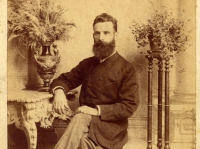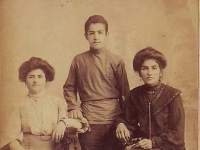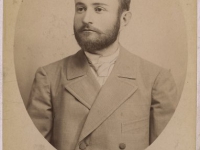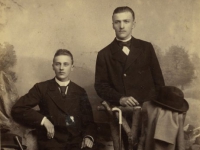Arriving in Tiflis in 1854, Grigor Ter-Ghevondyants soon befriended the noted Armenian writer and photographer Pertch Prochyan.[i] It is unlikely that the young man was already familiar with photographic techniques, but this friendship quickly blossoms into a partnership as both begun to study photographic techniques. It is possible that during the early 1860s, Ter-Ghevondyants operated one of the smaller studios in the Caucasus under Prochyan’s name.
A few years later in 1864 Ter-Ghevondyants opened his own studio near the Mikhaylov Bridge in Tiflis, becoming one of the first professional local photographers in the region. The prominence of his stature as an important master is evidenced by the fact, that almost all the members of the Armenian intelligentsia in Tiflis (then one of the centers of Armenian cultural life) had their portraits taken in his studio. This extensive gallery of prominent literary and theatrical figures includes such august names as Raffi, Mikayel Nalbandyan, Hovhannes Tumanian, Komitas, Gabriel Sundukian, Grigor Artsruni, Ghazaros Aghayan, Hakob Paronyan, Rafael Patkanyan, Father Khrimyan and actress Siranuysh.
His was undoubtedly on close friendly terms with many of his subjects and these portraits served not as mere records of individual writers or artists, but became a much needed sources of collective iconography for the Armenians around the region. Perhaps inspired by the French photographer Nadar’s similar project, Ter-Ghevondyants consciously documented the nation’s esteemed thinkers as a contribution to the formulation of the rapidly growing national consciousness. Growing up in and formed by this rich intellectual and artistic milieu, Ter-Ghevondyants’s son Anushavan eventually became one of the first notable Armenian composers.
Possibly influenced by 19th century theories on physiognomy, Ter-Ghevondyants focused on the face of his ‘important’ sitters, perhaps believing that the character and the soul of his subjects could be read on their facial features. They are quite unlike the usual studio fare, depicting frozen, blank faces, overdressed with studio props. He also utilised painterly techniques, such as high-contrast or diffuse lighting to give the portraits more atmosphere and mood. Of particular importance in this regard are his portraits of actress Siranuysh in her various roles. Taken in the studio, these are masterful photographic recreations of famous literary personages from the repertoire of the actress, proving the photographer’s deep interest in psychology and ideas around identity.
A seminal figure in the medium’s development in the Caucasus and the Near East, Ter-Ghevondyants’s oeuvre awaits a deeper study and proper evaluation.
[i] Biographical details taken from Vahan Kotchar, Hay lusankarichner [Armenian photographers], in Armenian, self-published, Yerevan, 2007, pp 358-363








